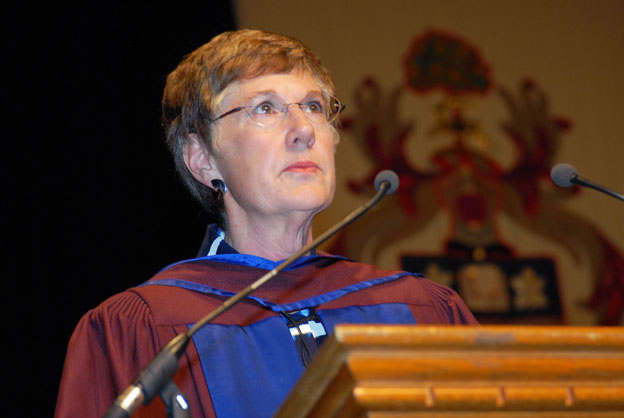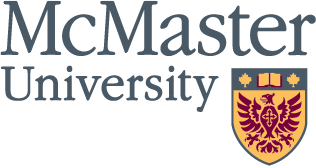‘Remembrance Day universally Canadian’: Chancellor Labarge

Suzanne Labarge spoke for the first time as McMaster’s new Chancellor Monday at the University’s Remembrance Day ceremony in Convocation Hall. Her remarks, in their entirety, are below.
As Canadian society becomes increasingly diverse, the number of things we share universally as individual Canadians becomes smaller, but ever more significant.
Our wonderful mosaic has focused our concept of Canadian-ness more sharply and allowed us to unite around key ideas that retain and even celebrate the variety of perspectives and experiences that constitute our nation.
To me, Remembrance Day is one of those things that should be universally Canadian.
Irrespective of heritage, language, religion or politics, every one of us has reason to appreciate and participate in the freedoms that our dominion provides. That concept may, in fact, be the single idea that is most fundamentally Canadian.
In that context, Remembrance Day is less about ceremony than it is about using occasions such as this to find a personal connection, a personal point of access into the heart of our mission for the day which is to remember that our privileges came at a cost. It was a cost paid by tens of thousands of Canadians so that millions more would not have to.
I found my own point of connection this summer in two simple sentences – 15 words – carved in stone near Reviers, France.
Reviers is a village of less than 1,000 people today, but in 1944 it found itself at the epicentre of world history.
On June 6 of that year, the Allied forces launched Operation Overlord. We know the date and operation better as D-Day. Among other troops and airborne support, our nation contributed the 3rd Division and the 2nd Armoured Brigade to the landing force, coming ashore primarily at Juno Beach.
Five gut-wrenching days later, the Allies had secured the beach and surrounding headlands and began bringing ashore the invasion force that would end the war in Europe.
On the first day of Operation Overlord – just the first day – Canadian troops sustained nearly a thousand casualties, including 340 killed.
This summer, I had the honour of visiting the Beny-sur-Mer Canadian War Cemetery just outside of Reviers. The cemetery contains 2,049 graves … more than double the number of people living in the nearby village.
It is an overwhelming experience to be among that many headstones so connected to a single moment, especially a moment so important to our national identity and to world history. But what struck me most – the point where I found my personal entrance into that overwhelming experience – was in the dates on the gravestones.
Stone after stone, row after row, I saw memorials for hundreds upon hundreds of men who were shockingly young when they died. As the new Chancellor of McMaster, it struck me with particular force that at another time, instead of being at war, these young Canadians would have been on this campus, in our classrooms, labs and residences.
Our fallen soldiers could have – should have – been working summer jobs on D-Day or, perhaps, like Nairn S. Boyd and Robert Edmund Dorsey, should have been working as new professionals with fresh McMaster degrees.
Instead, Nairn Boyd and Robert Dorsey are listed on the McMaster Honour Roll. Both are members of the Class of ’41. Boyd died in a tank battle the day before his younger brother met the same fate. Dorsey was killed by an enemy aircraft on D-Day plus one. Both alumni are buried at Beny-sur-Mer.
So many of the Canadians interred at Beny-sur-Mer – like Mac grads Boyd and Dorsey – were so young that I could not help but imagine their families. I could not help but imagine their parents – still young themselves – grieving the loss of a child … or even children. I could not help but imagine the younger brothers and sisters left behind.
That’s what really hit home. That’s what became my personal connection to Remembrance Day. It was the sudden and heartfelt understanding of the price that so many families paid for the freedoms that can too easily disappear into the contemporary noise and activity of our busy modern nation.
I took a photograph of the inscription on one of the headstones. Like all the others, it was a simple marker, clean and white. One of 2,049. The inscription reads, “What greater gift could a son give? His life for others in freedom to live.”
For me, for this year and maybe forever, that will be my pathway into Remembrance Day. I hope that each of you finds your own pathway … for today, we remember as the McMaster family and as a nation.

